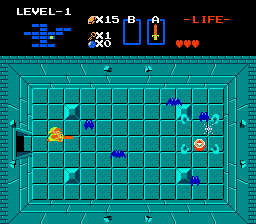
 |
|
Amid an RPG world dominated by the name Final Fantasy, Nintendo's Zelda series has always managed to stand tall. The original Legend of Zelda is known to many as a classic NES RPG and has spawned numerous sequels over the years. Yet, no matter how advanced the Zelda series becomes, fans will always fondly remember the original for its timeless, endearing qualities. The game revolves around a young hero named Link whose destiny it is to defend the land of Hyrule from Ganon, an evil thief who has stolen the Triforce of Power. Link's ultimate goal is to collect the eight pieces of the Triforce of Wisdom, an object with mystical and mysterious powers, and to wield it in the name of all that is good to save the Princess of Hyrule, Zelda. The pieces of the Triforce are kept in eight hidden dungeons found throughout Hyrule, and Link must master many various weapons and puzzles to collect them all.
The overworld of The Legend of Zelda is shown as one map divided into numerous squares. Each of these squares represents a segment of the world map. Certain areas of the map can be accessed only after Link has solved certain puzzles or has acquired certain weapons or items. Often, there is only one clue to a puzzle, if any at all. Missing one of these clues could very well result in hours of hopeless wandering. A classic example of this is the Lost Woods, a portion of the overworld with an exit on all four sides of the screen. The eastern exit leads safely out of the maze; the other three trails, however, deceivingly lead to a replica of the woods. Only by traveling through the northern, western, and southern passages in a certain pattern can you emerge from the western side into new territory. The catch is that the pattern is given at just one out-of-the-way point of the game as a mere set of directions, with no mention of where those directions apply; the gamer has to make that connection.
The underworld dungeons, or labyrinths, work similarly to the overworld, with a map segmented into squares that represent individual rooms. Rather than being a dull rectangle like the overworld map, the labyrinth maps take specific, recognizable shapes; the first is in the form of an eagle, the second a crescent moon, and so on. Progress through these dungeons is hindered by monsters, locked doors, and magically sealed doors that open only after a certain task (defeating enemies or moving a certain block) is performed. Many times, what appears to be a solid wall can become the entrance to a hidden room when blown down by a bomb. In the second quest, there is even an abundance of apparently solid walls that Link can simply walk through in order to advance!
Unlike most RPGs, fighting random enemies doesn't increase Link's strength. The Legend of Zelda works in an entirely different, but innovative, fashion. Hidden all over the world and in every labyrinth are "heart containers," that, when retrieved, increase Link's life meter. This is the only way to grow stronger in the game, because the gathering of heart containers is also related to the acquisition of new swords. After retrieving a certain number of hearts, Link can have a stronger blade bestowed upon him. Fighting is as simple as aiming the weapon of choice and pressing the attack button, but some enemies have weak spots, are more vulnerable to some weapons than others, or are invulnerable to a certain weapon entirely. It's always important to be aware of which enemy you're fighting and know its weaknesses!
In addition to the swords, there are many other useful weapons and items to find that are absolutely necessary to complete the game. The bow and arrow are needed to slay the one-eyed gargantuan crab Gohma, the recorder's melody is the only thing that makes the Digdogger vulnerable to attack, and the silver arrow is the key to defeating Ganon and beating the game. Link can acquire new items either by purchasing them from merchants or by discovering them in the darkest recesses of the labyrinths. He can also obtain potions to replenish his life, which turn out to be life savers on more than one occasion. It's sometimes difficult to find a dungeon when clues are few and far between, but exploring the world in the name of adventure is, at the same time, what gives Zelda much of its appeal. Searching for hidden staircases, trying to locate a labyrinth's treasure, and methodically bombing every wall in the overworld in search of a secret room are just some of the endearing activities that make the game both trying and fun. Other treats make the game unique as well, such as spending hours on end gambling rupees away to old men or being fined for breaking down the doors of hermits' hideaways.
The Legend of Zelda treats the gamer to a second quest upon finishing the first. The second quest is set in the same world as the first, but the location of every dungeon (with the exception of the first) is changed, the structure of every maze is different, and every item that was so painstakingly hunted down in the first quest is moved and rehidden in an entirely different location! Zelda was a different type of gaming experience when it was first released, a trailblazer, and remains a gaming classic to this day. While it may have lacked the elaborate plot and sharp graphics of latter day RPGs, Zelda's forté was, and always will be, gameplay. Perhaps the game's greatest attribute was the ability it granted gamers to freely explore an entire world at their own pace with very few limiting factors. This adventuring spirit and feel is what draws most people to the Zelda series in general and to the original in particular. Retrospective by Tamzen Marie Baker. Edited by Brian Maniscalco. |
|
||||||||||||||||||||||||||||||||||||||||||||||||





